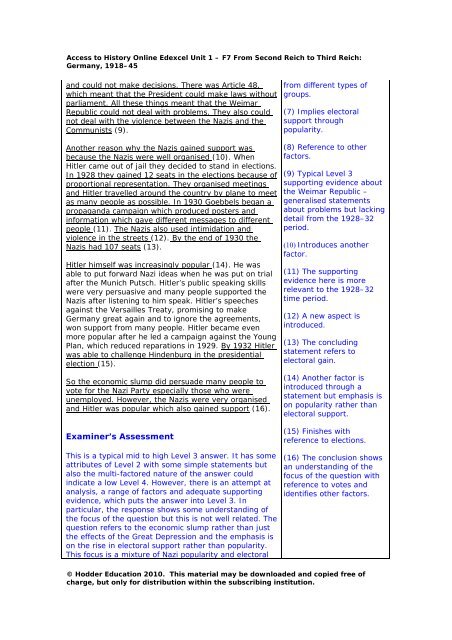F7 From Second Reich to Third Reich - The Student Room
F7 From Second Reich to Third Reich - The Student Room
F7 From Second Reich to Third Reich - The Student Room
Create successful ePaper yourself
Turn your PDF publications into a flip-book with our unique Google optimized e-Paper software.
Access <strong>to</strong> His<strong>to</strong>ry Online Edexcel Unit 1 – <strong>F7</strong> <strong>From</strong> <strong>Second</strong> <strong>Reich</strong> <strong>to</strong> <strong>Third</strong> <strong>Reich</strong>:Germany, 1918–45and could not make decisions. <strong>The</strong>re was Article 48,which meant that the President could make laws withoutparliament. All these things meant that the WeimarRepublic could not deal with problems. <strong>The</strong>y also couldnot deal with the violence between the Nazis and theCommunists (9).Another reason why the Nazis gained support wasbecause the Nazis were well organised (10). WhenHitler came out of jail they decided <strong>to</strong> stand in elections.In 1928 they gained 12 seats in the elections because ofproportional representation. <strong>The</strong>y organised meetingsand Hitler travelled around the country by plane <strong>to</strong> meetas many people as possible. In 1930 Goebbels began apropaganda campaign which produced posters andinformation which gave different messages <strong>to</strong> differentpeople (11). <strong>The</strong> Nazis also used intimidation andviolence in the streets (12). By the end of 1930 theNazis had 107 seats (13).Hitler himself was increasingly popular (14). He wasable <strong>to</strong> put forward Nazi ideas when he was put on trialafter the Munich Putsch. Hitler’s public speaking skillswere very persuasive and many people supported theNazis after listening <strong>to</strong> him speak. Hitler’s speechesagainst the Versailles Treaty, promising <strong>to</strong> makeGermany great again and <strong>to</strong> ignore the agreements,won support from many people. Hitler became evenmore popular after he led a campaign against the YoungPlan, which reduced reparations in 1929. By 1932 Hitlerwas able <strong>to</strong> challenge Hindenburg in the presidentialelection (15).So the economic slump did persuade many people <strong>to</strong>vote for the Nazi Party especially those who wereunemployed. However, the Nazis were very organisedand Hitler was popular which also gained support (16).Examiner’s AssessmentThis is a typical mid <strong>to</strong> high Level 3 answer. It has someattributes of Level 2 with some simple statements butalso the multi-fac<strong>to</strong>red nature of the answer couldindicate a low Level 4. However, there is an attempt atanalysis, a range of fac<strong>to</strong>rs and adequate supportingevidence, which puts the answer in<strong>to</strong> Level 3. Inparticular, the response shows some understanding ofthe focus of the question but this is not well related. <strong>The</strong>question refers <strong>to</strong> the economic slump rather than justthe effects of the Great Depression and the emphasis ison the rise in elec<strong>to</strong>ral support rather than popularity.This focus is a mixture of Nazi popularity and elec<strong>to</strong>ralfrom different types ofgroups.(7) Implies elec<strong>to</strong>ralsupport throughpopularity.(8) Reference <strong>to</strong> otherfac<strong>to</strong>rs.(9) Typical Level 3supporting evidence aboutthe Weimar Republic –generalised statementsabout problems but lackingdetail from the 1928–32period.(10) Introduces anotherfac<strong>to</strong>r.(11) <strong>The</strong> supportingevidence here is morerelevant <strong>to</strong> the 1928–32time period.(12) A new aspect isintroduced.(13) <strong>The</strong> concludingstatement refers <strong>to</strong>elec<strong>to</strong>ral gain.(14) Another fac<strong>to</strong>r isintroduced through astatement but emphasis ison popularity rather thanelec<strong>to</strong>ral support.(15) Finishes withreference <strong>to</strong> elections.(16) <strong>The</strong> conclusion showsan understanding of thefocus of the question withreference <strong>to</strong> votes andidentifies other fac<strong>to</strong>rs.© Hodder Education 2010. This material may be downloaded and copied free ofcharge, but only for distribution within the subscribing institution.
















